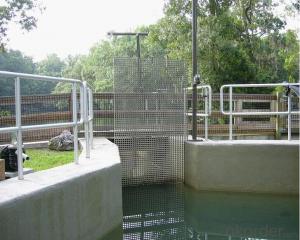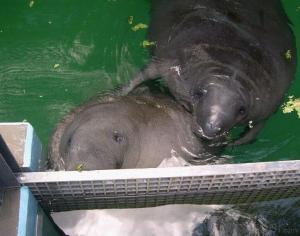anti-corrosive FRP grating aimpact resistance 2015
- Loading Port:
- Shanghai
- Payment Terms:
- TT OR LC
- Min Order Qty:
- 10 pc
- Supply Capability:
- 8000 pc/month
OKorder Service Pledge
OKorder Financial Service
You Might Also Like
Specification:
FRP molded grating made of vertical and horizontal continuous fiberglass fully soaked in unsaturated polyester resin giving perfect bi-directional mechanical properties. Combining unmatched corrosion resistance with strength, long life and safety, molded grating provide the ultimate in reliable performance, even in the most demanding corrosive conditions. Besides, it is easy to cut and install. CNBM offer the widest selection with panel sizes, colors and slip resistant surfaces, clients can avail FRP grating your specific requirements.
Product Features:
- Light but high loaded strength
- High anti-corrosion and anti-aging
- Easy installation and maintenance
- Low maintenance
- Non-conductive
- Lowest in life cycle cost
- Corrosion Resstance
- Anti-slippery
- Various sizes and color available
Colour Design:
To satisfy customer's design project, CNBM grating offers a wide selection of grating colors to choose from. The standard colors available for fiberglass grating as following:
- Blue
- Red
- Yellow
- Green
- Light Grey
- Dark Grey
Custom colors of fiberglass grating may be available upon request, you can contact us learn more.
Moded Grating Sizes List:
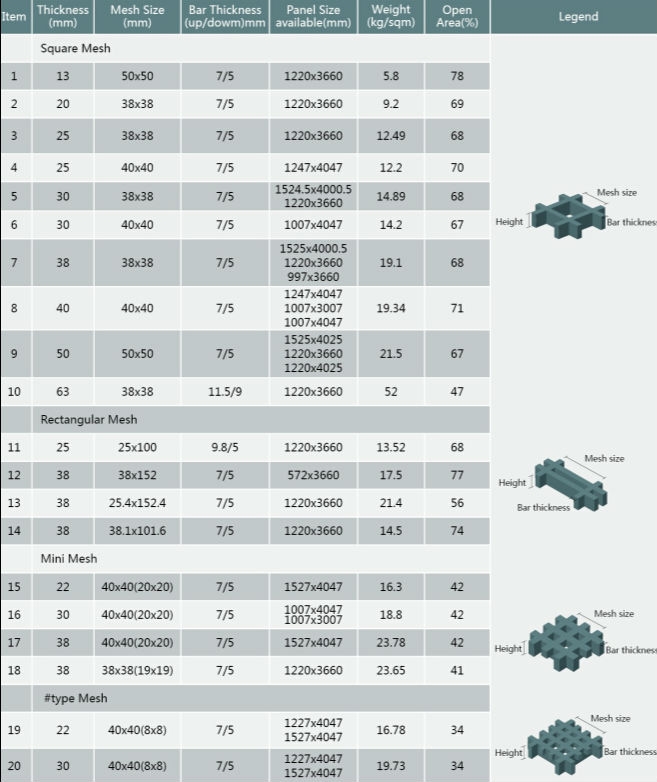
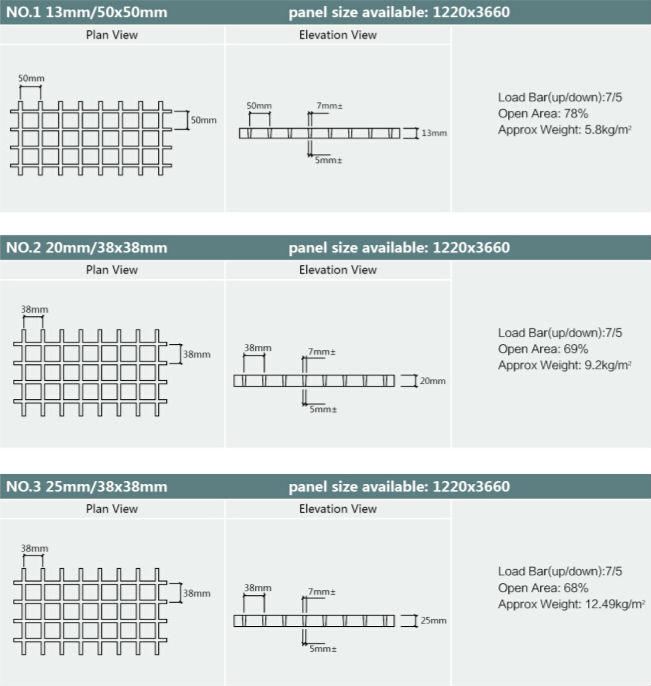

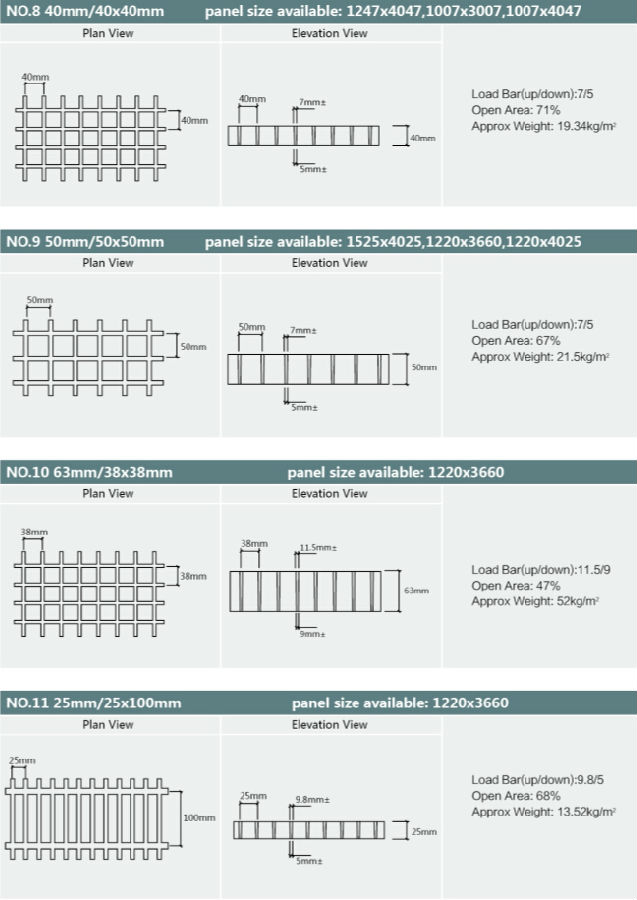
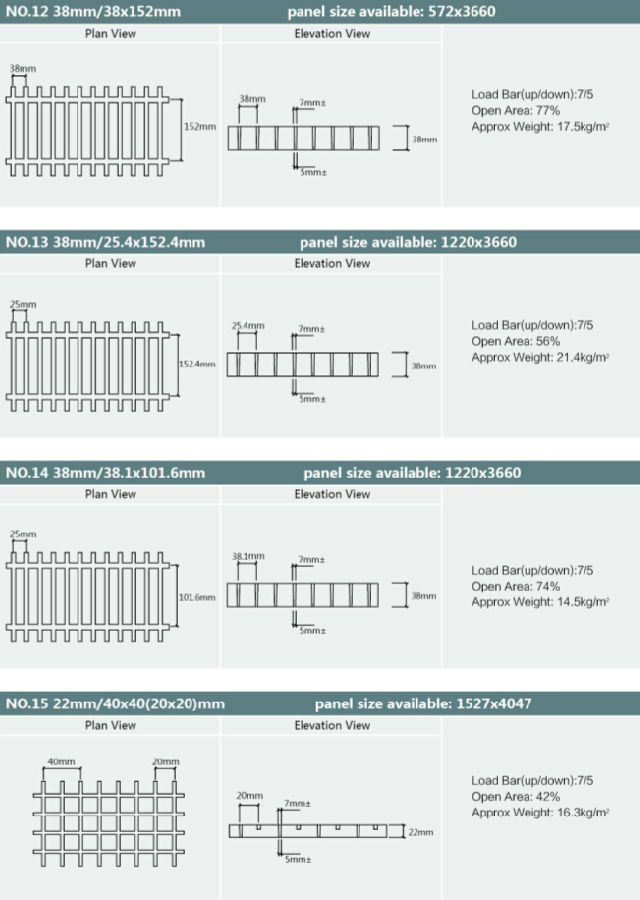
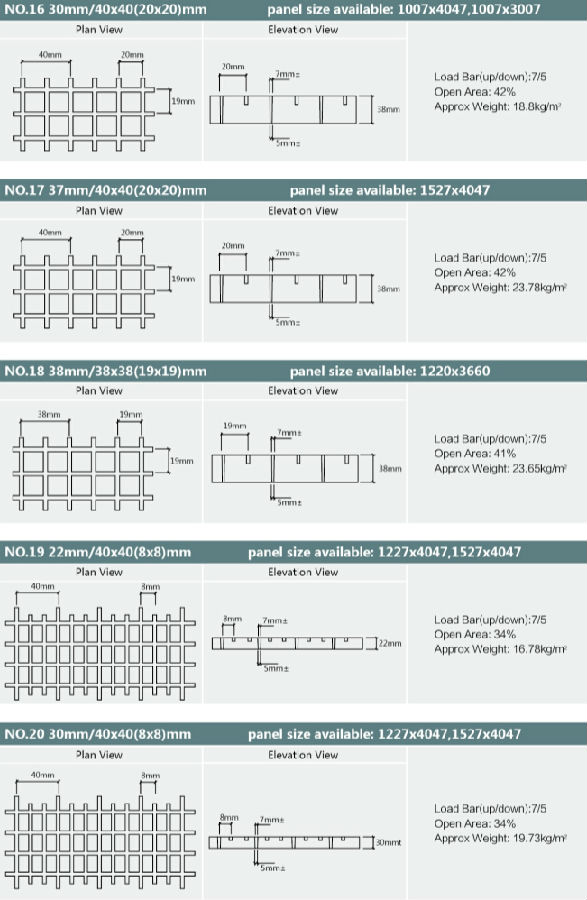
- Q:Can FRP pultrusion profiles be used in the construction and building materials industry?
- Yes, FRP pultrusion profiles can be effectively used in the construction and building materials industry. These profiles offer several advantages such as high strength-to-weight ratio, corrosion resistance, and dimensional stability, making them suitable for a wide range of applications including structural elements, handrails, gratings, and reinforcements. Additionally, FRP pultrusion profiles can be easily customized to meet specific project requirements, making them a popular choice in the industry.
- Q:Can FRP profiles replace carbon steel profiles?
- I am a man of glass fiber reinforced material. Honestly, "I can't do it."". Can be used in buildings, such as insulation, corrosion protection, aging resistance, flame retardant, etc.,
- Q:Are FRP pultrusion profiles resistant to chemicals used in mining operations?
- FRP pultrusion profiles, commonly referred to as Fiber Reinforced Polymer, generally exhibit resistance to chemicals commonly used in mining operations. These profiles are well-known for their exceptional chemical resistance properties, making them suitable for a variety of corrosive environments, including mining operations. To provide resistance against the vast array of chemicals typically found in mining applications, such as acids, alkalis, solvents, and corrosive gases, the resin matrix used in FRP pultrusion profiles can be carefully selected. Additionally, the reinforcement fibers, often composed of glass or carbon, further enhance the overall chemical resistance of the profile. Moreover, FRP pultrusion profiles are non-conductive, making them an ideal choice for both electrical and mining applications. They are not susceptible to corrosion or degradation when exposed to chemicals, ensuring their durability and longevity in harsh mining environments. However, it is crucial to consider the specific chemicals and concentrations used in mining operations. Although FRP pultrusion profiles generally possess excellent chemical resistance, prolonged exposure to highly aggressive chemicals or high concentrations may necessitate additional measures. These measures could include selecting specific resin systems or applying surface coatings to ensure optimal performance and longevity. To determine the most suitable materials for specific mining chemical environments, it is advisable to consult with FRP manufacturers or experts.
- Q:Can FRP pultrusion profiles be used in the aerospace and aviation industry?
- Yes, FRP pultrusion profiles can be used in the aerospace and aviation industry. These profiles offer several advantages such as high strength-to-weight ratio, excellent corrosion resistance, and electrical insulation properties. They can be used in various applications including aircraft interiors, structural components, and electrical systems. Additionally, FRP pultrusion profiles can be customized to meet specific design requirements, making them suitable for use in the aerospace and aviation industry.
- Q:Can FRP pultrusion profiles be used in railway applications?
- FRP pultrusion profiles are applicable in railway industries due to their high strength-to-weight ratio, durability, and resistance to corrosion. They can be utilized for various railway components such as sleepers, bridges, platforms, cable management systems, and structural support for tracks. These profiles possess exceptional mechanical properties, including high stiffness and tensile strength, which are crucial for maintaining the safety and integrity of railway infrastructure. Moreover, FRP pultrusion profiles exhibit low thermal conductivity, making them resistant to extreme temperature fluctuations commonly encountered in railway applications. Another significant advantage of employing FRP pultrusion profiles in railway settings is their resistance to corrosion. Unlike steel, FRP does not rust or corrode when exposed to moisture or chemicals. Consequently, the need for regular maintenance is reduced, thus extending the lifespan of railway components and reducing costs in the long term. Furthermore, FRP pultrusion profiles can be easily tailored to meet specific design requirements. They can be manufactured in various shapes, sizes, and colors, allowing engineers to create customized solutions for diverse railway applications. In summary, the use of FRP pultrusion profiles in railway industries offers numerous benefits, including lightweight design, high strength, corrosion resistance, and customization options. These qualities make FRP an appealing alternative to traditional materials, thereby enhancing the safety, efficiency, and longevity of railway infrastructure.
- Q:Are FRP pultrusion profiles resistant to fungal growth?
- FRP pultrusion profiles are generally resistant to fungal growth. The composite materials, like resins and fibers, used in pultrusion possess inherent resistance to biological degradation, including attacks from fungi. The non-porous nature of FRP pultrusion profiles also poses difficulties for fungi to penetrate and grow on the surface. Furthermore, the manufacturing process involves curing the composite materials at high temperatures, which adds to their resistance against fungal growth. However, it is important to acknowledge that no material is entirely impervious to fungal growth in all conditions. Factors such as high humidity, prolonged exposure to moisture, and inadequate maintenance practices can still contribute to fungal growth on FRP pultrusion profiles, albeit to a lesser extent compared to materials like wood or metal. Regular inspection and appropriate cleaning are crucial to sustain the fungal resistance of FRP pultrusion profiles throughout their lifespan.
- Q:How do FRP pultrusion profiles perform in extreme cold temperatures?
- FRP pultrusion profiles generally perform well in extreme cold temperatures. The composite materials used in their construction have low thermal conductivity, which helps in retaining their mechanical properties even in freezing conditions. However, it is important to consider the specific resin system and reinforcement used in the profiles, as different formulations may exhibit slightly varying performance characteristics. Overall, FRP pultrusion profiles are known for their excellent resistance to temperature variations, making them suitable for use in cold environments.
- Q:Do you have any high temperature resistant resin made of pultruded glass fiber reinforced plastic?
- High temperature resistant resin heding sculpture factory used, can reach 300 degrees, you can go to Baidu or Taobao to find sellers. It seems that the material suppliers in Guangdong are selling, and they are all made of glass fiber reinforced plastic sculptures. The weather resistance is better.
- Q:Are FRP pultrusion profiles electrically conductive?
- Typically, FRP pultrusion profiles lack electrical conductivity due to the utilization of a blend of fiberglass reinforcement and a thermosetting resin matrix. These components offer exceptional insulation qualities. The inherent non-conductive nature of the fiberglass reinforcement is further amplified by the resin matrix. Consequently, FRP pultrusion profiles find frequent application in situations where electrical conductivity is undesirable or poses safety hazards. Nevertheless, it is noteworthy that specific modifications or additions can be implemented during the pultrusion process to introduce electrical conductivity, if needed for particular applications.
- Q:Can FRP pultrusion profiles be used in architectural or decorative applications?
- Yes, FRP pultrusion profiles can definitely be used in architectural or decorative applications. FRP, which stands for Fiber Reinforced Polymer, is a composite material that combines strong fibers, such as glass or carbon, with a polymer resin matrix. This combination creates a lightweight, durable, and corrosion-resistant material that is ideal for various applications, including architecture and decoration. FRP pultrusion profiles can be manufactured in a wide range of shapes and sizes, making them highly versatile for architectural and decorative purposes. These profiles can be used to create aesthetically pleasing structures, such as columns, beams, and facades, that enhance the visual appeal of buildings. Additionally, FRP pultrusion profiles can be fabricated to mimic the appearance of other materials, such as wood or metal, allowing for the creation of decorative elements that blend seamlessly with the overall design. Furthermore, FRP pultrusion profiles offer several advantages over traditional materials commonly used in architecture and decoration. They are lightweight, which makes them easier to handle and install, reducing labor costs. They are also highly resistant to corrosion, weathering, and UV radiation, ensuring long-lasting performance in outdoor applications. Additionally, FRP profiles can be customized to meet specific design requirements, including color, texture, and surface finish, providing endless possibilities for creative expression. In summary, FRP pultrusion profiles are a viable option for architectural and decorative applications. Their lightweight, durable, and customizable nature makes them suitable for a wide range of design needs, while their corrosion resistance ensures longevity and low maintenance. Whether it's for structural support or decorative embellishments, FRP pultrusion profiles offer an excellent choice for enhancing the aesthetics and functionality of architectural and decorative projects.
1. Manufacturer Overview |
|
|---|---|
| Location | |
| Year Established | |
| Annual Output Value | |
| Main Markets | |
| Company Certifications | |
2. Manufacturer Certificates |
|
|---|---|
| a) Certification Name | |
| Range | |
| Reference | |
| Validity Period | |
3. Manufacturer Capability |
|
|---|---|
| a)Trade Capacity | |
| Nearest Port | |
| Export Percentage | |
| No.of Employees in Trade Department | |
| Language Spoken: | |
| b)Factory Information | |
| Factory Size: | |
| No. of Production Lines | |
| Contract Manufacturing | |
| Product Price Range | |
Send your message to us
anti-corrosive FRP grating aimpact resistance 2015
- Loading Port:
- Shanghai
- Payment Terms:
- TT OR LC
- Min Order Qty:
- 10 pc
- Supply Capability:
- 8000 pc/month
OKorder Service Pledge
OKorder Financial Service
Similar products
New products
Hot products
Related keywords
